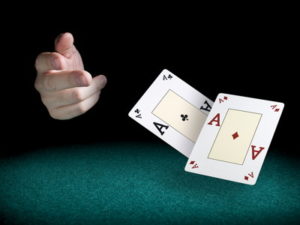 As the famous old Kenny Rogers song goes “You’ve got to know when to hold ’em, know when to fold ’em”.
As the famous old Kenny Rogers song goes “You’ve got to know when to hold ’em, know when to fold ’em”.
This is because knowing when to hold and when to fold is a crucial poker skill and one the most important elements of any sound poker strategy.
Playing too many hands pre flop in Texas Hold’em can result in doing damage to your win rate as well as your bankroll. This is why the world’s top poker players, both live and online, fold regularly and, most of the time, only play with a strong hand.
Folding Your Hand Pre flop
 Leading Texas Hold’em players fold around 75% of all starting hands before play gets underway. You can set yourself up for success in later betting rounds by having a solid pre flop strategy. In order to work out when the optimum time to fold before the flop is, you should figure out a set of hand ranges that you are willing to use from each position at the poker table. There are plenty of hand range charts that you can find online to help you establish a decent pre flop strategy.
Leading Texas Hold’em players fold around 75% of all starting hands before play gets underway. You can set yourself up for success in later betting rounds by having a solid pre flop strategy. In order to work out when the optimum time to fold before the flop is, you should figure out a set of hand ranges that you are willing to use from each position at the poker table. There are plenty of hand range charts that you can find online to help you establish a decent pre flop strategy.
These charts can help to show you whether or not to play a hand or drop out altogether. They can also show you what hands to open raise with from each position and which hands you should be calling or raising with against an opponent who has already bet before your turn.
A strong pre flop strategy will see you playing tighter in an early position as well as making a lot of folds prior to the flop. You can then add more hands to your range in the later positions.
It goes without saying but premium hands such as pocket AA, KK, QQ or AK can be open raised from any position but as you work your way closer to the button you might want to add more hands to your game including low suited connectors or small pairs such as pocket threes and twos.
When to Fold After the Flop
 As soon as the flop lands, everything changes. Committing to the same strategy that you were using pre flop can spell disaster because the pots can inflate hugely at this point. However, there are signs that you can look out for that will help you to know when to make a post flop fold. These include watching out for an opponent that never bluffs but is betting big.
As soon as the flop lands, everything changes. Committing to the same strategy that you were using pre flop can spell disaster because the pots can inflate hugely at this point. However, there are signs that you can look out for that will help you to know when to make a post flop fold. These include watching out for an opponent that never bluffs but is betting big.
Or, alternatively, when you have played a pocket pair pre flop and more than two over cards land, or if you have no pair or drawing potential with your hand post flop. It is a good idea, then, to muck your cards as well if do have some drawing potential, but do not have decent enough pot odds to make a call. Finally, while it may seem rather obvious, you should fold when you don’t have a strong enough hand after the flop.
In all, there are a total of 169 unique combinations of possible starting hands, of which some are obviously going to be better than others. It goes without saying that pocket AA are the best, while 27 off suited is the worst.
An experienced poker player will likely limit themselves to the top 15% of hands, which means that they will be folding around 85% of the time. If you are facing a wild opponent who is playing a lot of hands then you should be folding a lot less of the time against them, staying alive and calling their bluffs.
And, like wise, if you are playing an opponent who is super tight and sitting out most of the hands before suddenly livening up, then you are probably better off folding. It is highly likely that the cards have fallen their way and they are, all of a sudden, holding a much stronger hand than they previously had. After all, they didn’t suddenly spring to life for nothing.
At the end of the day, poker is all about instinct so it is really just a case of reacting to what your opponents do as, while this isn’t necessarily always going to be the case, when you have deduced what type of player you are up against you will be aware of whether they raise with a weak hand or not.
